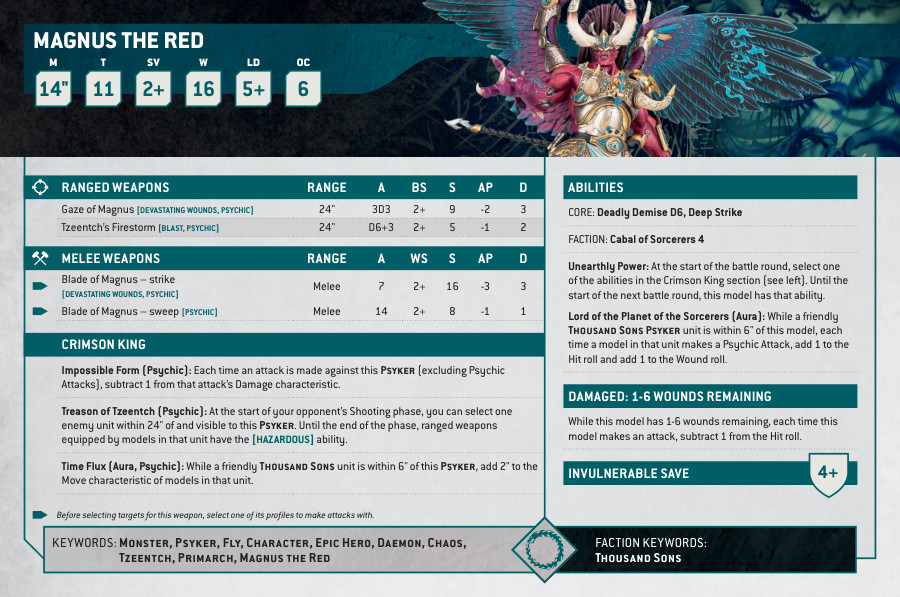Behold the awe-inspiring arrival of Magnus the Red, as the very fabric of reality quakes beneath his descent. A towering Thousand Sons figure, born of the Emperor of Mankind, he defies logic and reason. Merely catching a glimpse of him is to risk the fragility of one’s sanity, for when the Crimson King’s piercing gaze meets yours, devastation follows in its wake. Possessing psychic mastery second only to the Emperor himself, he effortlessly shatters the boundaries of existence with a single stroke of his blade, obliterating even the most formidable of super-heavy vehicles with the sheer force of his wrath.
But Magnus the Red is not confined to the ground; with mighty wings unfurled, he soars through the skies, reveling in his supernatural might and bringing untold calamity upon those who dare to oppose him. As his colossal form takes flight, the world trembles beneath his otherworldly power, and his adversaries are left in terror.
Magnus the Red Datasheets
What’s in the Magnus the Red box
- x76 plastic parts that make Magnus the Red, Daemon Primarch of Tzeentch. An imposing winged model whose size is appropriate to his power, he comes with a selection of 3 different faces (cyclopean, open helm and closed helm), is clad in armour dating from before the dark days of the Horus Heresy and has an array of modelling options: accessories include magical tomes, scrolls and daggers. He’s armed with the frankly ostentatious Blade of Magnus, modelled as a choice of glaive or sword.
- x1 Citadel 100mm Round base on which you can also add a crushed Space Wolf Dreadnought as an extra detail
Magnus the Red FAQs
Who is Magnus the Red, and what is his significance in the Warhammer 40,000 universe as one of the Primarchs?
Magnus the Red is one of the Primarchs in the Warhammer 40,000 universe. He holds significant importance as the Primarch of the Thousand Sons Legion, known for their psychic abilities and pursuit of knowledge.
What are some notable characteristics and abilities of Magnus the Red as a Primarch and the Primarch of the Thousand Sons Legion?
Magnus the Red possesses immense psychic power, considered one of the most potent psykers among the Primarchs. He has exceptional mastery over sorcery, telepathy, and precognition. His physical form is also distinctive, with red skin, a single cyclopean eye, and immense stature.
What are some details about Magnus the Red’s background and the events that led to his transformation into a Daemon Primarch?
Magnus the Red’s background involves the planet Prospero, where he and his Legion, the Thousand Sons, delved into forbidden knowledge and sorcery. In an attempt to save his Legion from a psychic catastrophe, Magnus utilized a dangerous sorcerous ritual that inadvertently led to his transformation into a Daemon Primarch.
How does Magnus the Red’s allegiance to Tzeentch, the Chaos God of change and sorcery, shape his actions and influence his Legion and the forces of Chaos?
Magnus the Red’s allegiance to Tzeentch greatly influences his actions and those of the Thousand Sons Legion. As the Chaos God of change, manipulation, and sorcery, Tzeentch’s influence drives the Thousand Sons’ pursuit of arcane knowledge and the weaving of intricate plans. Magnus and his Legion embrace the intricate schemes and mutating power offered by Tzeentch, but their loyalty to the Chaos God also brings inherent risks and dangers.
What are some key events or campaigns in which Magnus the Red played a prominent role during the Great Crusade, the Horus Heresy, or subsequent events in the Warhammer 40,000 universe?
Throughout the Great Crusade and the Horus Heresy, Magnus the Red and the Thousand Sons Legion played notable roles. Magnus attempted to warn the Emperor of Horus’ betrayal through a psychic message, but due to the Emperor’s psychic barriers, the warning went unheeded. As a result, the Thousand Sons faced the devastating Burning of Prospero, where they were nearly annihilated by their own fellow Space Marine Legions. Magnus later participated in the Siege of Terra, seeking to atone for his actions and aid the Imperium, although the full extent and outcome of his involvement remain subjects of speculation and interpretation within the lore.









